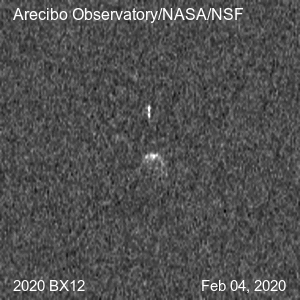Fox News Flash top headlines for Feb. 13
Fox News Flash top headlines are here. Check out what's clicking on Foxnews.com.
A "potentially hazardous asteroid" that whizzed past Earth earlier this month is so large it has its own "moon."
According to radar images from the Arecibo Observatory, asteroid 2020 BX12 has a smaller asteroid that is 230 feet (70 meters) in diameter orbiting it. Asteroid 2020 BX12 is nearly 1,500 feet (450 meters) in diameter, according to NASA's Center for Near-Earth Object Studies.
"Radar images obtained by the Arecibo Observatory on the 4th and 5th of February revealed that near-Earth asteroid 2020 BX12 is a binary asteroid," the observatory wrote in a statement on its website.

(Credit: Arecibo Observatory)
EARTH'S OLDEST ASTEROID STRIKE MAY HAVE ENDED 'SNOWBALL EARTH'
Arecibo Observatory added: "The movement of the satellite between the two observations, which were made ~23 hours apart, suggests a mutual orbital period of 45-50 hours and would be consistent with a tidally locked satellite. Due to projection effects, uncertainties remain on the rotation periods, and a shorter mutual orbital period of 15-16 hours has not yet been ruled out."
A binary asteroid is a two-asteroid system that has one common center. Nearly 400 binary and triple asteroid systems have been discovered, according to Johnston Archive.
Though asteroid 2020 BX12 is considered a "potentially hazardous" near-Earth object (NEO) because of its size and minimum orbit intersection distance of 188,000 miles from Earth, it "poses no danger at this time and is currently receding from Earth," Arecibo added.
"Potentially hazardous" NEOs are defined as space objects that come within 0.05 astronomical units and measure more than 460 feet in diameter, according to NASA.
According to a 2018 report put together by Planetary.org, there are more than 18,000 NEOs.
NASA has been preparing for planetary defense from asteroid strikes for years. A recent survey showed that Americans prefer a space program that focuses on potential asteroid impacts over sending humans back to the moon or to Mars.




















